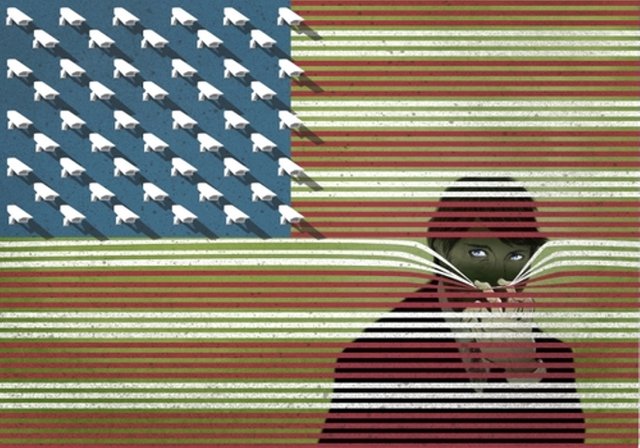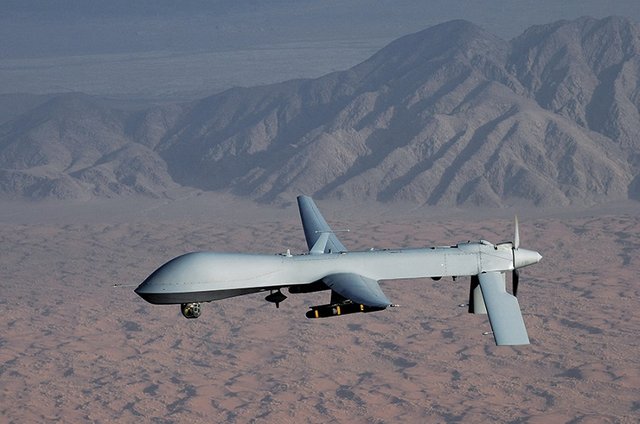Surveillance State Pt 10
Drones, Drones Everywhere.

Manufacturers call them unmanned aerial vehicles (UAVs)—or, more grandly, unmanned aircraft systems (UASs)—but the rest of the world calls them drones. As drone applications proliferate, rules on their use and boundaries that should apply remain unclear. In this lecture, you’ll learn about drone technology so that you might better understand how drones works and what they are capable of. Then, you’ll examine some domestic uses of drones. Furthermore, you’ll consider some unique legal and policy issues, asking how we, as a society, are going to deal with this technology.
How Drones Work
● For most people, the word “drone” conjures up the image of a lethal, missile-armed Predator or Reaper, such as the drones deployed in the Iraq and Afghanistan wars and afterward. Once the United States demonstrated the Predator’s capabilities, drones became an indispensable military tool—and part of our vocabulary. But military drones are a small fraction of the types of drones used in the United States and around the world today.
● The Israelis were the first to design the modern, glider-type drone in the 1970s. They built small, lightweight devices, making them inexpensive to build—and difficult to shoot down. Larger drones soon followed, and today some of them are quite large.
● Thousands of drone platforms now exist for a wide variety of purposes, from scientific research to military operations. Drones are employed by governments and by the private sector.
● Drones themselves are unmanned, but they are controlled by a human operator. These remote operators typically are highly skilled and must be trained for their particular missions.

● In the military, drone pilots learn how to carry out intelligence, surveillance, and reconnaissance missions and also how to conduct and respond to electronic attacks, implement strike missions with weapons, conduct search-and-rescue operations, and so on. For the military, remote piloting greatly reduces the risks to U.S. personnel and makes the vehicles cheaper to produce.
● The last point often gets overlooked. Although drones are unmanned, trained crews steer the craft, analyze the images that the cameras send back, and act on what they see. In the military context, that might mean firing missiles at a surveilled target. In a civilian context, it might mean taking photographs.
● Drones are not autonomous—at least not yet. A human is always in the loop. The control base for this remotely piloted vehicle can be anywhere that you are able to establish a communications link.
● The control system is the most intricate part of the system. Commands from the controller are encrypted and uplinked to satellite, which then downlinks the commands to the drone. Drone sensor data flows back along the same channel—or, if you want, the sensor data can be directly shared with others.
What Drones Do
● Drones are used in both military and domestic applications.
● In 2015, the Pentagon reportedly controlled about 7,000 military-grade drones—up from fewer than 50 at the start of the 21st century. Thesehave been used increasingly in military missions overseas, first running reconnaissance and then targeting al-Qaeda operatives in Afghanistan, Iraq, Pakistan, Somalia, Yemen, and elsewhere.
● Meanwhile, such hostile groups as the Islamic State of Iraq and alSham (ISIS), Hamas, and Hezbollah are said to have obtained their own
drones. The inevitable result of such proliferation is that malevolent uses could become a problem in the United States.
● The Department of Homeland Security uses drones for Border Patrol security. These vehicles conduct surveillance of areas and routes that are inaccessible to regular patrols. Likewise, we use drones over the ocean to maintain maritime domain awareness and to track shipping headed to the United States.
● We use drones for emergency preparation and disaster response. Before the next hurricane hits, drones will have planned evacuation routes and
anticipated vulnerable locations. In the immediate aftermath of as major storm, they also allow us to observe the catastrophic effects and begin remediation planning. And drones can provide emergency restoration of cell phone coverage.
● By providing a visible police presence, drones deter criminal behavior in unpatrolled areas. United Nations peacekeepers are using drones for the same kinds of reasons.
● In agriculture, farmers use drones to monitor crop growth at a local level and in greater detail than might be provided, for example, by satellite photos. Drones have even been used as a replacement for cropdusting airplanes as a way of spraying pesticides and eradicating pest infestation.
● Meanwhile, scientists and environmentalists are increasingly using drones for environmental monitoring, as well. With these aerial vehicles, we can track wildlife, monitor droughts (or flooding), and watch the stability of locks, dams, and levees in remote areas.
● With the right equipment, drones can sample the pollution over our cities and test concentrations of carbon dioxide concentration in remote locations. They might even fly into the eye of a hurricane without risking human life. Anywhere that humans can go or might want to go—to see or do something—is potentially a place where drones can lead us.
● One of the most interesting commercial applications is the use of drones by newsgathering operations. Drones are much cheaper to operate than traffic helicopters. And when large demonstrations occur, they can provide a safe platform for news gathering.
● Of course, drones are also going to be used by paparazzi to stalk celebrities. Film crews are another big user. Drones are cheaper and easier to use than helicopters. Big retailers and package-delivery services are interested in drones as distribution vehicles to reach consumers.
● Just as news organizations might want to employ drones to watch a riot as it unfolds (or some other event, for that matter), the government wants drones to enhance its law-enforcement and homeland security capabilities.
● We can readily imagine some government uses that would be appropriate—for example, for search-and-rescue missions. But still, because of their surveillance capabilities, drones could impinge on personal privacy and other civil liberties without proper legal guidelines and oversight.
● The proliferation of drones in our skies might also threaten aviation safety. We can prohibit certain uses altogether, of course. Using a drone to case a house for a burglary will still be a crime, just as burglary is now. And it is a near certainty that the Peeping Tom laws will be modified, if they need to be, to include a prohibition on drones.
● But hard questions will come from mixed uses—instances where data collection includes collateral collection of information and imagery. Market predictions suggest that the manufacture and sale of drones will be a multibillion-dollar industry. Whether we like it or not, drones are here to stay. Given their utility, it seems far more likely that we will control drone use through rules and regulations rather than ban them.
● First, there will be safety regulations. When first presented with the question, an administrative law judge said that absent written rules, the Federal Aviation Administration (FAA) couldn’t regulate drones, because the court viewed them as being no different than model aircraft.
● That led the FAA to issue its first commercial drone license in June 2014, to BP (the former British Petroleum), which had requested permission to use a 13-pound drone to survey its equipment and pipelines in Prudhoe Bay, Alaska.
● At the same time it issued that first license, the FAA moved to restrict everyone else who didn’t have one. Later, the FAA issued a draft of its proposed rules for hobbyists. They proposed that we can freely fly our small remote-controlled drones (weighing less than 50 pounds) as long as the drones stay away from airports, keep below 400 feet, and remain within the controller’s sight.
● Anyone else, including news organizations, package-express companies, and retailers would have to wait for new regulations or get a one-off exemption. Few exemptions were issued initially (mostly for closed movie sets).
● It’s possible that a final rule would require the operators of large drones to obtain air-worthiness certificates and fly them with licensed pilots. These requirements would be quite expensive. In the meantime, the current general prohibition stands.
Legal and Policy Issues
● Privacy and civil liberties issues pose still more interesting questions. On one side are some academic researchers who have been following the FAA debate. They contend that the FAA-imposed restrictions on drones would jeopardize their work and undermine basic education.
● On the other side of the coin is the state of California. California’s legislature adopted a law requiring police departments throughout the state to get a warrant from a judge in almost every situation where they might use a drone, except for emergencies such as a hostage taking.
● Imagine that while on patrol for counterterrorist purposes, a drone spots images that might convey a drug deal. Or they could just be pictures of two guys meeting in the woods. Should the analysts who collect this data share it with the local police department?
● On one hand, the answer seems to be clearly yes. We don’t want government officials to turn a blind eye during the course of their duties to a crime they happen upon. The Fourth Amendment, which prohibits unreasonable searches and seizures, likely would be no legal barrier to sharing the information.
● On the other hand, there’s a good argument for the answer to be no. One way in which we limit government activities that impinge on civil
liberties is through use limitations—that is, the idea that information and data collected for a specific use can be used only for the particular purpose.
● One idea is to pass a law that would authorize data collected for counterterrorism purposes to be shared with police for other purposes only if those purposes involved “responding to, or otherwise preventing or mitigating, an imminent threat of death or serious bodily harm.”
● The following are some other limitations that we might consider for drones.
◗ The use of drones in a military capacity would be severely restricted to situations of actual invasion or insurrection.
◗ The use of drones for domestic surveillance of First Amendment activity would be considered fundamentally at odds with U.S. constitutional principles and be prohibited.
◗ Drones equipped with novel sensor arrays would not be permitted, absent a clearly demonstrated need and a careful consideration of countervailing privacy and civil liberties concerns.
◗ Drones would not be used as a platform for the collection of massive unstructured data sets because that type of collection could form the basis for sophisticated tracking and behavioral analytics.
◗ Drones would be considered unsuitable for use as a routine means of surveillance in nonthreatening situations.
● For all of these ideas, value judgments and choices need to be made. So, Congress has to be engaged. Technology and the law need to be harmonized to ensure that the state remains secure and its people remain free.
Questions to Consider
Are drones different from helicopters? Why, or why not?
Should you be allowed to stop a drone from flying over your house?
Would you want a drone delivering pizza to you?
